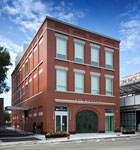Project
LOCATION Chicago
Size 14,000 ft2
Completed 2011
Program Exhibition area, teaching space, events space, storage, and offices
During peak hours, a train passes through the Fullerton stop on Chicago’s elevated tracks every one to two minutes. Outside of rush hour, this tapers slightly—to about three minutes—but within 24 hours nearly 700 trains come through the station, screeching and rattling their way through the city.
Visitors inside DePaul University’s new art museum, however, can’t hear or feel even one of these trains thunder past, despite being mere feet from the tracks.
The three-story building, designed by Antunovich Associates, is steadied by caissons that plunge 60 to 70 feet below ground. Its façade is brick and limestone, and behind that lies two inches of rigid insulation and twelve inches of concrete block. The windows are triple-pane, argon insulated, low-E glass with a U-value of 0.3. In effect, the trains that pass by every minute or so amount to little more than a movie with the sound turned off. Why such structural considerations? Vibrations could easily harm the museum’s sensitive works of art.

The new museum's materials were chosen to match Lincoln Park's characteristic red-brick buildings, which can be seen here, looking east toward Lake Michigan.
Team
ARCHITECT Antunovich Associates
Owner DePaul University
General Contractor Bulley & Andrews
When DePaul University moved its art collection into the new space at 935 West Fullerton Avenue, the El tracks weren’t the design’s only influential factor. Fullerton Station borders DePaul Art Museum to its west, but on the east stands a row of Seminary Townhouses, late 19th-century buildings from the student housing days of McCormick Theological Seminary. The buildings are the face of Lincoln Park, the historic neighborhood DePaul calls home, and are uniformly red brick and three stories with arched doorways and windows. The art museum’s conservative façade and wide, arched front window match them neatly.
Which was the point.
“All of the work we’ve done at DePaul is very respectful of the … environment in which these buildings are located,” says Joe Antunovich, who has worked on master planning and architecture for the university for 29 years, even before he started his own firm in 1990. “The building … fits into the streetscape and the surrounding urban fabric in a way that is very complementary.”
Antunovich Associates completed a classroom building for DePaul in 2009, the Andrew J. McGowan Science Building, which earned LEED Gold certification. A new School of Music building slated to break ground in 2013 will pursue LEED points as well. Although still pending at the time of writing, the DePaul Art Museum is on track to receive LEED Silver certification.

All interior materials had to satisfy the stringent requirements necessary for preserving the art, resulting in indoor air quality nearly fit for a medical lab.

The new art museum, targeting LEED Silver certification, doubled DePaul's gallery space and added a sizable teaching area. Seen here is one of Nick Cave's Soundsuits.
Green
CERTIFICATION LEED Silver (expected)
Windows Triple-pane, argon insulated, low-E glass
Air Quality Conditions required for art improve air quality
Systems Variable frequency drives installed on motors and fans
The stringent requirements of a museum’s indoor environment make the building type “difficult to plan and design with standard practices,” says Tak Louie, Antunovich Associates’ project manager. “So to introduce green practices makes it more challenging.”
Even so, the building nearly maxed out the Indoor Environmental Quality section of its LEED Scorecard.
“Because of the need to have sophistication for the care of the artwork, the residual effect is that the individuals working there are working in lab-type conditions,” Antunovich says, laughing. “Certainly the envy of many people at the university.” Full points, for example, were achieved in Controllability of Systems, in part through the use of variable frequency drives installed on motors and fans. “The volume and variation of air movement is very responsive to any changes in capacity or any sudden changes in environmental temperatures,” Antunovich says, a bonus in Chicago’s mercurial climate.
In addition to buffering noise and vibrations from the trains, the triple-glazed windows also help save energy costs. The low-E glass assemblies were produced by Oldcastle Glass. The LSI lights, which balance both art-illumination and energy-conservation goals, are ceramic metal halide bulbs with a life expectancy of 10,000 hours installed on 300-watt tracks.
All efforts were most of all focused on making a building that would endure. “We are building an environment that protects these precious things—the art—so that they are here for our ancestors and for our descendants over the long haul,” Antunovich says.
This, he explains with a trademark phrase of his, is “a different definition of green.”

